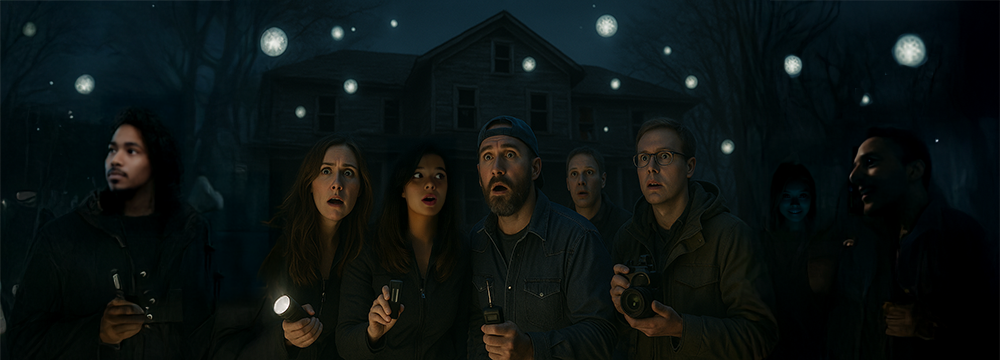Orbs: Dust or Paranormal?
Picture this: camera in hand, you’re creeping through an old building. You snap a photo with your flash, and there it is—your image, littered with glowing orbs. Are they ghosts or just dust having its 15 minutes of fame?
Spoiler Alert: Those orbs are almost always dust, debris, bugs, or other mundane particles caught in your camera’s flash. But don’t toss your EMF meter just yet! Let’s explore the science behind orbs and discuss a list of orb traits that might hint at something exciting. Grab your flashlight, and let’s dive into the science of photography!
What Are Orbs?
Orbs are those pesky, glowing circles that pop up in photos, especially when using a flash in low-light settings. They can be bright, faint, translucent, or even slightly colored. Paranormal TV shows swear orbs are spirits, energy vortices, or Great-Aunt Mildred. Ghost-hunting blogs are stuffed with orb photos.
But here’s the catch: Orbs are mostly airborne particles—dust, pollen, or water droplets—reflecting your camera’s flash. The digital camera boom of the 2000s made orbs a household name as compact cameras moved the built-in flashes ever closer to the lens.
The Science:
Orbs are dust particles lit by your camera’s flash. When you snap a photo with a flash, your camera blasts light into the world. That light hits whatever is in front of you—chairs, walls, or that creepy porcelain doll collection—and bounces back to create the image. But if dust, pollen, or a water droplet is floating near your lens, the flash lights it up, and poof—you’ve got an orb. Dust particles are often inches from the lens, far too close to be in focus. This blurs them into soft, circular shapes. The flash’s light hits the particle and scatters, some of it bouncing straight back to your camera.
Compact digital cameras have small sensors and short focal lengths, which makes out-of-focus particles appear larger and more rounded. Sitting right next to the lens, the flash is perfectly positioned to catch every little speck. Dust isn’t always a perfect sphere, but its tiny size and the camera’s optics smooth it into a circle. The orb’s size depends on how close the particle is and your camera’s settings.
Let’s bust some myths:
“Orbs fly around like they’re on a mission!”
Nope. Dust drifts on air currents, looking purposeful in photos or videos. Long exposures can make them seem aware, but it’s just physics, not intelligence.
“I see faces in orbs!”
That’s pareidolia, your brain’s knack for finding familiar patterns in randomness. Like seeing a horse in the clouds or a face in the rocks.
- “Orbs only haunt spooky places!”
- Dust doesn’t care if you’re in a graveyard or a restaurant. Dust is everywhere.
- “Orbs glow on their own!”
- If they did, you’d see them without a flash. Try snapping a picture in the dark without a flash. No orbs.
Now we’ve established that 99% of orbs are composed of dust, pollen, or moisture in the air. But what about that 1%? That one photo or video that makes you go, “Well, that’s odd.” The one photo we are looking for is when we go out investigating. Here’s a list of orb traits that warrant further investigation:
- Independent Glow: If an orb appears in a photo without a flash, and you can’t explain it with ambient light (like a street lamp or moonlight).
- Consistent Patterns: Orbs that form repeating shapes across multiple photos, like a perfect triangle or spiral. That could hint at something beyond dust and debris.
- Interaction with Objects: If an orb seems to dodge around physical objects (like weaving between tree branches) in a way that defies air currents, it might be more than debris.
- Visible to the Naked Eye: If you see the orb with your eyes before snapping the photo, and it’s not a firefly, that’s a red flag.
- Colorful Anomalies: Most orbs are white or pale, but if one’s glowing neon pink or pulsing, it could be something more exciting than pollen.
These are rare, and even then, double-check to ensure it’s not a lens flare, camera glitch, or reflections off shiny surfaces. But don’t just take my word for it. Shake a blanket in a dark room and snap photos with your flash—yup, orb city. Now try the same without the flash. No orbs? Yeah. I didn’t think so. Photographers avoid orbs by using off-camera flashes and diffusers.
So why do we keep seeing spirits in specks? Blame our brains. Ghost-hunting shows and TikTok paranormal vids hype orbs as proof of the afterlife, and who doesn’t want to believe? Confirmation bias makes us spot orbs in “haunted” places and ignore them in family photos at the park.
Orbs in photos are a crazy mix of science, optics, and human imagination. They’re almost always dust and debris, lit up by your camera’s flash. But next time you spot one, check for those anomalous traits—just in case.





 KGRAdb.com
KGRAdb.com